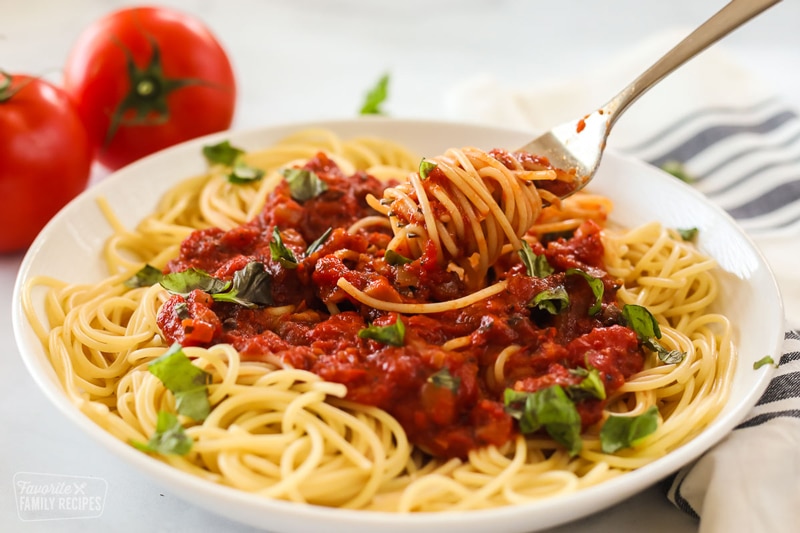Contents
There’s something undeniably comforting about a plate of pasta coated in a rich and flavorful tomato-based sauce. While store-bought options are readily available, nothing quite beats the taste and satisfaction of homemade tomato-based spaghetti sauce. By preparing your own sauce from scratch, you have control over the ingredients, flavors, and customization. In this article, we will explore the benefits of making homemade tomato-based spaghetti sauce, the necessary ingredients and equipment, and provide a step-by-step guide to help you create a delicious sauce that will elevate your pasta dishes.
Benefits of Homemade Tomato-Based Spaghetti Sauce
A. Healthier Option When you prepare your own tomato-based spaghetti sauce, you can be confident that you are opting for a healthier alternative. Many store-bought sauces contain preservatives, additives, and excessive amounts of sodium or sugar. By making your own sauce, you can avoid these unnecessary ingredients and have peace of mind knowing exactly what goes into your food. Additionally, homemade sauces allow you to control the quality of the ingredients you use. You can opt for fresh and ripe tomatoes, ensuring a higher nutritional value compared to canned alternatives. B. Customization and Flavor Enhancement One of the greatest advantages of homemade tomato-based spaghetti sauce is the ability to customize it according to your taste preferences. You can experiment with various herbs, spices, and additional ingredients to create a sauce that perfectly complements your desired flavors. Whether you prefer a mild and aromatic sauce or a spicy and bold one, the choice is entirely yours. Furthermore, by using fresh herbs and spices, you can enhance the flavors of your sauce in ways that are simply not possible with store-bought options. The aroma of sautéed onions and garlic, coupled with the richness of herbs like basil or oregano, adds depth and complexity to your sauce, making it truly irresistible.Ingredients and Equipment Needed
A. Tomato Varieties The star ingredient of homemade tomato-based spaghetti sauce is, of course, tomatoes. While there are numerous tomato varieties available, it’s essential to choose ones that are suitable for sauce making. Varieties like Roma or San Marzano tomatoes are known for their rich flavor and low water content, making them ideal for sauce preparations. However, you can also use other varieties based on your personal preference and availability. B. Additional Ingredients In addition to tomatoes, you will need a few more ingredients to enhance the flavor of your sauce. Onions and garlic form the base of many tomato-based sauces, providing a savory and aromatic foundation. Fresh herbs like basil, oregano, or thyme add a burst of freshness and complexity to the sauce. Olive oil, salt, and a pinch of sugar are also necessary to balance the flavors. C. Equipment Required To prepare homemade tomato-based spaghetti sauce, you will need a few essential kitchen tools. A saucepan or pot is necessary for cooking the sauce. A blender or food processor will come in handy to achieve a smooth and consistent texture, although this step is optional if you prefer a chunkier sauce.Step-by-Step Guide to Making Homemade Tomato-Based Spaghetti Sauce
A. Preparing the Tomatoes Start by selecting ripe and flavorful tomatoes. Look for tomatoes that are deep red, firm, and fragrant. Avoid using overripe tomatoes, as they can make the sauce too watery. Once you have your tomatoes, blanch them in boiling water for a minute or two, then transfer them to an ice bath. This process will make peeling the tomatoes easier. Once cooled, remove the skins and discard them. B. Sautéing the Aromatics Heat some olive oil in a saucepan over medium heat. Add finely chopped onions and minced garlic to the pan and sauté until they become translucent and fragrant. This process helps to release the flavors and aromas of the onions and garlic, providing a robust foundation for your sauce. Next, add your chosen herbs and spices to the pan, such as basil, oregano, or thyme. Sauté them for a minute or two to further enhance their flavors and aromas. Be mindful not to burn the garlic or herbs, as it can result in a bitter taste. C. Cooking and Simmering the Sauce Now it’s time to add the prepared tomatoes to the pan. If you prefer a smoother sauce, you can crush the tomatoes with your hands or use a potato masher to break them down. Stir the ingredients well, ensuring the tomatoes are evenly distributed. Reduce the heat to low and let the sauce simmer gently for at least 30 minutes. This slow cooking process allows the flavors to meld together and intensify. Stir occasionally to prevent the sauce from sticking to the bottom of the pan. D. Blending or Processing the Sauce Once the sauce has cooked and thickened to your desired consistency, you have the option to blend or process it for a smoother texture. Using a blender or food processor, carefully puree the sauce until it reaches the desired smoothness. Remember to let the sauce cool slightly before blending to avoid any accidents due to steam. If you prefer a chunkier sauce, you can skip this step altogether. E. Adjusting the Seasonings Taste the sauce and adjust the seasonings according to your preference. Add salt to enhance the flavors, sugar to balance the acidity, or additional herbs and spices for an extra punch of taste. Keep in mind that the flavors will continue to develop as the sauce sits, so it’s better to slightly under-season at this stage.Tips for Perfecting Homemade Tomato-Based Spaghetti Sauce
A. Tomato Selection Tips When selecting tomatoes for your sauce, choose ripe ones that are slightly soft to the touch and have a sweet aroma. Tomatoes with deep red colors tend to have a more intense flavor. If you’re fortunate enough to have access to vine-ripened or homegrown tomatoes, they will undoubtedly elevate the taste of your sauce. B. Flavor Enhancements Don’t be afraid to experiment with different herbs and spices to enhance the flavors of your sauce. Fresh basil is a classic choice, but you can also try adding other herbs like parsley, thyme, or rosemary to create a unique flavor profile. If you prefer a hint of sweetness, a touch of balsamic vinegar or grated carrots can do the trick. C. Storing and Freezing the Sauce If you have leftover sauce or want to make a larger batch, it’s important to store it properly. Allow the sauce to cool completely before transferring it to an airtight container. Store it in the refrigerator for up to 5 days or freeze it for longer-term storage. To freeze, divide the sauce into smaller portions and place them in freezer-safe containers or bags. Remember to label them with the date for easy reference.Conclusion
Homemade tomato-based spaghetti sauce offers numerous benefits, from being a healthier option to providing the freedom to customize and enhance flavors according to personal preferences. By following a step-by-step guide, you can create a delicious sauce that will elevate your pasta dishes to new heights. Experiment with different tomato varieties, herbs, and spices to find your perfect flavor combination. With a little effort and creativity, you’ll never go back to store-bought sauce again.Tasty Bacon-free Carbonara Recipe
Can I Use Homemade Croissants in My Tomato-Based Spaghetti Sauce Recipe?
Can I incorporate homemade croissants into my tomato-based spaghetti sauce? While it may seem unconventional, the unique flavors of the buttery, flaky croissants can add an interesting twist to your sauce. To experiment with this idea, take a look at the beginner’s guide to homemade croissants to ensure you have a solid foundation before venturing into this fusion of cuisines.







